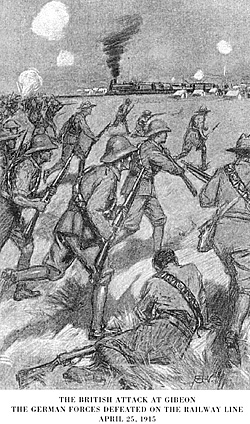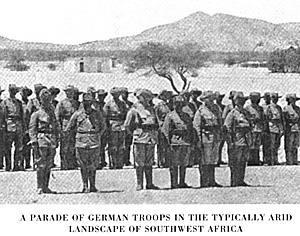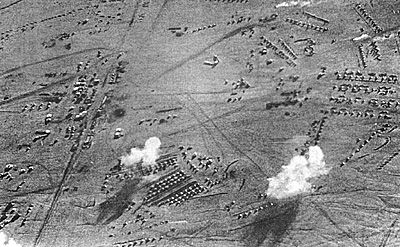 This time, Botha intended to take personal command. The forces
available to him consisted of a mixture of volunteers and regulars,
including a few British, and various other elements, among them a
squadron of armoured cars manned by the Royal Navy.
This time, Botha intended to take personal command. The forces
available to him consisted of a mixture of volunteers and regulars,
including a few British, and various other elements, among them a
squadron of armoured cars manned by the Royal Navy.
The British attack at Gibeon, German forces defeated on the railline, April 25, 1915.
Most of the volunteers served in the Mounted Burgher Corps, and were a mixed bunch of all ages, many of whom had previously fought against the British from Majuba onwards. In dress, appearance and equipment, they were virtually identical to the commandos of the Boer Wars.
The burghers could be formidable fighters, but were notoriously unreliable; on one occasion an outflanking movement against a German position was to be thrown into disarray when a commando sent to cut off the enemy retreat became distracted by the sight of game, and went off hunting! The Boers were generally unpopular with the regulars because of their indiscipline and also because of their insanitary habits, which attracted swarms of flies to their encampments. Only a commander with the diplomatic skills of Botha possessed the ability to keep such disparate forces together. Interestingly, the South Africans resisted black African hell). Although some uprisings against the German authorities took place anyway, the campaign was to be largely a 'white man's war'.
By February 1915 Botha was ready to begin the advance. There were to be two main thrusts, both heading towards the central plateau. The Northern Force, accompanied by Botha himself but Under the operational command of Brigadier General Sir Duncan MacKenzie, was to advance from Swakopmund eastwards towards the railway. Two other columns would advance on Keetmanshoop. One, the 'Eastern Force' under Colonel Berrange, would advance from Kuruman, whilst the 'Southern Force', a column led by LieutenantColonel Jacobus van Deventer, advanced from Upington, marching via Sandfontein and Warmbad.
The march proved to be particularly arduous for the Northern Force, which found itscif in contention with not only the Germans, but also hoards of flies, the fierce heat (over 130 degrees Fahrenheit) by (lay, and cold and (lamp by night. The Germans fought a guerrilla war of delaying tactics, making brief stands, launching opportunistic attacks, and poisoning wells and laying mines. The South Africans were particularly incensed by well-poisoning, though the Germans usually placed warning notices by the wells so treated, and it was said that the water was usually so foul anyway that the effects were rarely noticed. Certainly, there is no evidence of any resulting fatalities. The Germans (to riot appear to have suffered so much from the water problem as their opponents did, possibly because they seem to have drunk bottled beer. On more than one occasion, the opposing troops bartered beer and cigarettes.
The mines were more formidable affairs; manufactured by packing dynamite into 'T'-shaped pieces of 1/4 inch water pipe, they were sown in large numbers, and inflicted a number of casualties.
A novel feature of the campaign was airpower, albeit in a highly rudimentary form. Initially 'air superiority'. for what it was worth, lay with the Germans, who had two planes. But these could only fly in the cool of the early morning, and their only armament consisted of improvised bombs, manufactured from 4" artillery shells, with tail fins attached. They do not seem to have been very effective. In March, the Royal Navy supplied Botha with two BE 2c's, which promptly fell apart in the damp conditions. They obtained one accidental success, however, when von Heydebach was killed when an unexploded aerial bomb he was examining went off. Further planes arrived in May, but were too late to be used effectively.
 In the meantime, the South African columns kept up a steady
advance; on April 14th the eastern and Southern columns linked up,
and continued their push towards the central railway, threatening the
retreat of the German forces in the south, whilst the Northern Column
pressed on across the and wilderness of the Namib Desert.
In the meantime, the South African columns kept up a steady
advance; on April 14th the eastern and Southern columns linked up,
and continued their push towards the central railway, threatening the
retreat of the German forces in the south, whilst the Northern Column
pressed on across the and wilderness of the Namib Desert.
Union troops under fire during a skirmish in the desert sand.
The Germans continued to fight rearguard actions, and to fight back whenever they saw an opportunity. One such action occurred on April 25th at Trekkopjes. A column of South Africans and Rhodesians under Colonel Skinner had been sent to reconnoitre the railway beyond the settlement, when they collided with a German column moving to attack the Union forces. Skinner's men fell back on Trekkopjes, where they came tinder heavy attack.
As usual, the Germans, with their batteries of eight guns, had artillery superiority, whilst Skinner merely possessed an improvised anti-aircraft gun consisting of 1 pdr, mounted on a wagon wheel, which could only fire vertically and was known as 'Skinny Liz'. The Union forces were saved from a tight spot by the opportune arrival of the armoured cars of the Royal Navy, under the command of LieutenantCommander Whittal, which took the attacking Germans in the flank, and turned them back with machine-gun fire.
Botha continued his advance, and when Contacting the, enemy generally used his South African regulars to try to pin them down, whilst employing the mounted volunteers in doubt(flanking movements. On May 5th Botha occupied the important railway centre of Karibib, whilst on April 25th-26th, the Southern Force drove the main German force, now commanded by Major von Keist, back from Gibson towards Mariental.
The Germans, however, avoided being trapped, and headed away north, whilst Windhoek was occupied on May 12th.
By the stage, the campaign was effectively decided, but the Germans concentrated their remaining forces in a triangle formed by the settlements of Otavi, Tsumeb, and Grootfontein, where the Governor, Dr. Satz, had established his temporary headquarters.
 Though there was little realistic hope of prolonged resistance, the Germans
intended, if all else failed, to disband their reservists, while the regular
officers attempted to reach German East Africa and join the forces
there.
Though there was little realistic hope of prolonged resistance, the Germans
intended, if all else failed, to disband their reservists, while the regular
officers attempted to reach German East Africa and join the forces
there.
German troops on parade in the typically arid landscape of SW Africa.
Botha formed his troops into three columns in order to complete operations. In a typical pincer movement, General C. J. Brits was given command of the left column, the orders to advance on Namutoni, whilst Botha himself made a frontal attack along the main road next to the railway- A column on the right was to occupy Grootfontein. The advance began on the 18th, and there was a final skirmish at Tstimeb, where the main German supply base was located. On July 9th, the Germans recognised the inevitable, and surrendered. Botha granted generous terms, for which he was subsequently criticised in some quarters. Though the German officers and regulars were detained, the reservists were allowed to return home, and to retain their arms and ammunition to protect their farms against African attack.
In all, some 3,497 Schutztruppe surrendered. During the course of the campaign, the South Africans and Rhodesians had lost 113 men killed in action or died of wounds, 153 from disease or accident, and 263 wounded. German casualties were estimated at 1331 dead.
Further Reading
Much material on the campaign in German South-West Africa is either out-of-print and difficult to obtain, even through interlibrary loan, or consists of articles in South African military journals. However, the following accounts are useful;
'The Battle of Trekkopjes' by Doreen Barfield, Military Historical Journal, December 1971, Vol. 2, No. 2. The German Contribution to the Military History of South-West Africa', by H.J. Botha and J. Ploegar, Militaria, 2/4, 1970.
'The Great War in Africa', by Byron Farwell, 1987. 'General Louis Botha', by Johannes Mcintjes, 1970. 'The Action at Sandfontein', by J. Ploegar, Militaria, 4/1, 1973. 'Tanks and other Armoured Fighting Vehicles 1900-1918', by B.T.White, 1970.

More German Southwest Africa 1914-1915
Back to Colonial Conquest Issue 10 Table of Contents
Back to Colonial Conquest List of Issues
Back to MagWeb Master List of Magazines
© Copyright 1995 by Partizan Press.
This article appears in MagWeb (Magazine Web) on the Internet World Wide Web.
Other military history articles and gaming articles are available at http://www.magweb.com